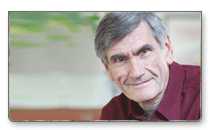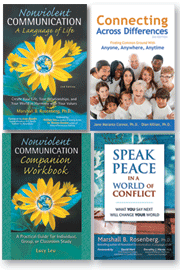The Heart of NVC, continued
While studying the factors that affect our ability to stay compassionate, I was struck by the crucial role that language can play. While we may not consider the way we talk to be “violent,” words often lead to hurt and pain toward ourselves or to others. That’s because so many of us have been trained to speak in terms of moralistic judgments, evaluations and labels that disconnect us from compassion.
I have since identified a specific approach to communicating - called Nonviolent Communication (NVC) - that leads us to give from the heart, connecting us in a way that allows our natural compassion to flourish.
NVC guides us to reframe how we express ourselves and how we hear others. Instead of habitual, automatic reactions, our words become conscious responses based firmly on awareness of what we perceive, feel and want in that moment.
Within the framework of NVC, we’re led to express ourselves with honesty and clarity, while simultaneously paying others a respectful and empathic attention. In any exchange, we come to hear our own deeper needs and those of others. NVC trains us to observe carefully, and to specify behaviors and conditions that are affecting us. The form is simple, yet powerfully transformative.
There is a story of a man on all fours under a street lamp, searching for something. A policeman passing by asked what he was doing. “Looking for my car keys,” replied the man, who appeared slightly drunk. “Did you drop them here?” inquired the officer. “No,” answered the man, “I dropped them in the alley.” Seeing the policeman’s baffled expression, the man hastened to explain, “But the light is much better here.”
Like this story, I find that my cultural conditioning leads me to focus attention on places where I am unlikely to get what I want. I developed NVC as a way to train my attention on places that have the potential to yield what I am seeking.
The use of NVC does not require that the persons with whom we are communicating be literate in NVC or even motivated to relate to us compassionately. If we stay motivated solely to give and receive compassionately, and do everything we can to let others know this is our only motive, they will join us in the process, and eventually we will be able to respond compassionately to one another.
I’m not saying that this always happens quickly. I do maintain, however, that compassion inevitably blossoms when we stay true to the principles and process of NVC.
To arrive at a mutual desire to give from the heart, we focus the light of consciousness on four areas - referred to as the four components of the NVC model.
First, we observe what the others are saying or doing that is either enriching or not enriching our life. The trick is to be able to articulate this observation without introducing any judgment or evaluation.
Next, we state how we feel when we observe this action: are we hurt, scared, joyful, amused, irritated? And thirdly, we say what needs of ours are connected to the feelings we have identified. An awareness of these three components is present when we use NVC to clearly and honestly express how we are.
For example, a mother might express these three pieces to her teenage son by saying, “Felix, when I see two balls of soiled socks under the coffee table and another three next to the TV, I feel irritated because I am needing more order in the rooms that we share in common.”
She would follow immediately with the fourth component – a very specific request: “Would you be willing to put your socks in your room or in the washing machine?” This fourth component addresses what we are wanting from the other person that would enrich our lives or make life more wonderful for us.
Thus, part of NVC is to express these four pieces of information very clearly, whether verbally or by other means. The other part of this communication consists of receiving the same four pieces of information from others. We connect with them by first sensing what they are observing, feeling and needing; then we discover what would enrich their lives by receiving the fourth piece - their request.
As we keep our attention focused on the areas mentioned, and help others do likewise, we establish a flow of communication, back and forth, until compassion manifests naturally: what I am observing, feeling, and needing; what I am requesting to enrich my life; what you are observing, feeling and needing; what you are requesting to enrich your life . . .
- The concrete actions we observe that affect our well-being
- How we feel in relation to what we observe
- The needs, values, desires, etc. that create our feelings
- The concrete actions we request in order to enrich our lives
The essence of NVC is in our consciousness of the four components, not in the actual words that are exchanged.
When we use NVC in our interactions - with ourselves, with another person or in a group - we become grounded in our natural state of compassion. It is therefore an approach that can be effectively applied at all levels of communication and in diverse situations.
Some people use NVC to create greater depth and caring in their intimate relationships. Others use it to build more effective relationships at work. Still others use this process in the political arena. Worldwide, NVC now serves as a valuable resource for communities facing violent conflicts and severe ethnic, religious or political tensions.
I feel blessed to be able to travel throughout the world teaching people a process of communication that gives them power and joy. Now, with my book Nonviolent Communication: A Language of Life, I am pleased and excited to be able to share the richness of Nonviolent Communication with you.
Marshall Rosenberg, Ph.D., is the author of Nonviolent Communication: A Language of Life, Speak Peace in a World of Conflict, Life-Enriching Education, and several booklets. He serves as the founder and director of educational services for the Center for Nonviolent Communication.
Keep learning these vital communication skills with these books and training resources:




